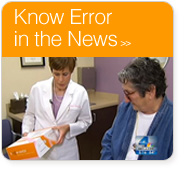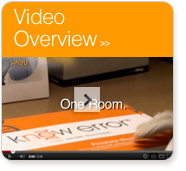FAQs
Answers to frequently asked questions about the know error system
What does the know error® system do?
Why is this system necessary?
What are Specimen Provenance Complications (SPCs)?
How does the know error® system work?
A buccal swab (cheek swab) is taken from the patient and sent to our DNA lab the same day as the biopsy procedure. The biopsy tissue sample(s) are placed in bar-coded jars from the biopsy kit and sent to the pathology lab for evaluation.
If the biopsy results come back positive for cancer (malignant), the pathology lab prepares tissue samples (scrolls taken from the paraffin blocks) and sends them to a DNA lab where a DNA Specimen Provenance Assay (DSPA) is performed to compare the DNA profiles of the biopsy tissue and the reference swab sample. A “match” of these profiles allows for absolute confirmation of patient identity. A report summarizing the test results is sent from the DNA lab.
What happens if a non-match is detected?
A client services representative will call the designated contact immediately to report the issue. We will conduct additional research to ensure someone internally is not the source of the non-match. Once that is verified, we strongly recommend that the lab re-cuts the block(s) in question to make new slides, has pathology read those slides for diagnosis and simultaneously cuts new scrolls for confirmation testing. A summary of the initial findings and an addendum to the original lab report will be issued within 2-3 days following receipt of the new tissue samples.
What are the different types of non-match results that may occur?
We segment the different types of non-match results into four main categories:
specimen transposition – tissue contains entirely different DNA profile than reference sample
extraneous/foreign cell contamination – second DNA source present in addition to patient being tested
quantity/quality not sufficient (QNS) – DNA is not of sufficient quantity or quality to provide a profile we can compare with the reference
genetic anomaly – discrepancy due to genetics of tissue sample
What is a genetic anomaly and how do you identify one?
A genetic anomaly occurs when the patient’s cancer causes a mutation in the cells of the tissue sample and gives the appearance of a non-match. In order to confirm the existence of a genetic anomaly, we must re-cut and re-test the tissue. If this yields the same result, we can confirm that the non-match is due to a genetic anomaly.
What does the biopsy kit include?
Each know error® system collection kit contains all the necessary components to collect biopsy samples with the added benefit of confirming that the specimens being evaluated belong to the patient being diagnosed. All components feature unique bar codes as an additional safety measure to protect against errors. Specific kit components include collection jars*, buccal swabs to collect the DNA reference sample, transport vials for malignant tissues, return mailers and a patient educational piece explaining the benefits of DNA testing.
*Some kits available with slides or cassettes.
What extra steps must my office take to use the system?
The know error® system involves minimal steps and can be implemented with little disruption to the standard biopsy collection process. The few extra steps include: 1) obtaining patient consent, 2) swabbing the patient’s mouth and 3) returning the swab in the provided mailer to the DNA lab. We provide training for the medical professionals and staff involved in the collection process.
Does this replace the biopsy kit I am currently using?
Yes, the know error® system biopsy kits provided will replace existing kits and can be used for all patients. Physician offices send tissue samples to the pathology lab in the same manner they are sent today. The only difference in the process is that the buccal swabs used to obtain the DNA reference sample are simply packaged in the return mailer (included in the kit) and shipped directly to our DNA lab following the biopsy procedure.
Do patients accept Know Error testing?
Biopsy patients have been very pleased that their physicians are taking the time and precaution to provide enhanced diagnostic accuracy and safety via the know error® system. Compliance with testing is nearly 100% and the process is both simple and efficient for patients.
Will the patient’s DNA information be safe?
All personal information is protected by the Health Insurance Portability and Accountability Act (HIPAA), a U.S. law designed to provide privacy standards to protect patients’ medical records and other health information provided to health plans, doctors, hospitals and other health care providers. Developed by the Department of Health and Human Services, these standards provide patients with access to their medical records and more control over how their personal health information is used and disclosed. Click here to review our comprehensive privacy policy.
Do you run the biopsy test looking for cancer?
We are not a pathology lab and do not diagnose cancer, but rather facilitate the process of making sure that the biopsy tissue is free from contamination (i.e. the samples are pure) and the tissue is ascribed correctly to the patient being evalutated.
Does use of the know error® system affect my relationship with my current pathology lab?
Your pathology lab will continue to provide pathology services as it is doing so today. If the biopsy results come back positive for cancer (malignant), a small piece of the paraffin blocked used to render the diagnosis will be sent to Know Error to test against the patient’s reference sample (buccal swab). The physician’s office and the pathology lab incorporate the know error® system in order to reduce the opportunity for diagnostic mistakes due to Specimen Provenance Complications (SPCs).
Do you have any literature/articles that speak to the frequency of errors?
Medical research, reports from respected news organizations and real-life cases document the existence of biopsy misidentification errors in the diagnostic testing cycle for cancer. Most recently, a 2013 study published in the American Journal of Clinical Pathology indicates that up to 3.5% of biopsies may be subject to undetected (occult) specimen transposition or contamination which could lead to a cancer diagnosis being assigned to the wrong patient.
Can you describe the specific DNA testing method that you use and comment on the accuracy of the results?
Our system uses DNA Specimen Provenance Assay (DSPA) to assign specimen identity when making the diagnosis of cancer and other histopathological conditions. A panel of 16 microsatellite short tandem repeat (STR) markers that recognizes highly variable loci of human DNA is used in a PCR-based assay and analyzed by capillary electrophoresis. The 16 STR loci range from approximately 75 to 400 base pairs in length, and are highly polymorphic in the human population. The collective data from this panel provides a genetic profile, or ‘DNA fingerprint,’ representing the individual. To complete the diagnostic testing cycle for cancer, the genetic profile from the putative malignant specimen(s) is compared with the genetic profile derived from the patient’s DNA reference sample taken via cheek swab at the time of the biopsy procedure.
What types of tissues do you accept?
We routinely test breast and prostate tissues. Other tissue types we have experience with include bladder, cervical, colon and endometrial. If you are interested in utilizing the know error® system on tumor types outside of what is listed, we can further investigate to determine clinical feasibility on a case-by-case basis. Please contact Customer Service with any questions on this matter at 1-888-924-6779, option 2.
How long does it take to receive the final Know Error DNA report?
Turn-around-time is 2-3 days for prostate tissue and 48 hours for breast tissue. Time frames vary for other tissue types that are not routinely tested at our lab.







